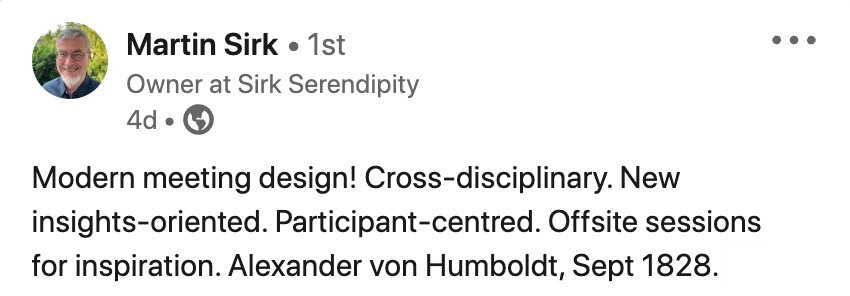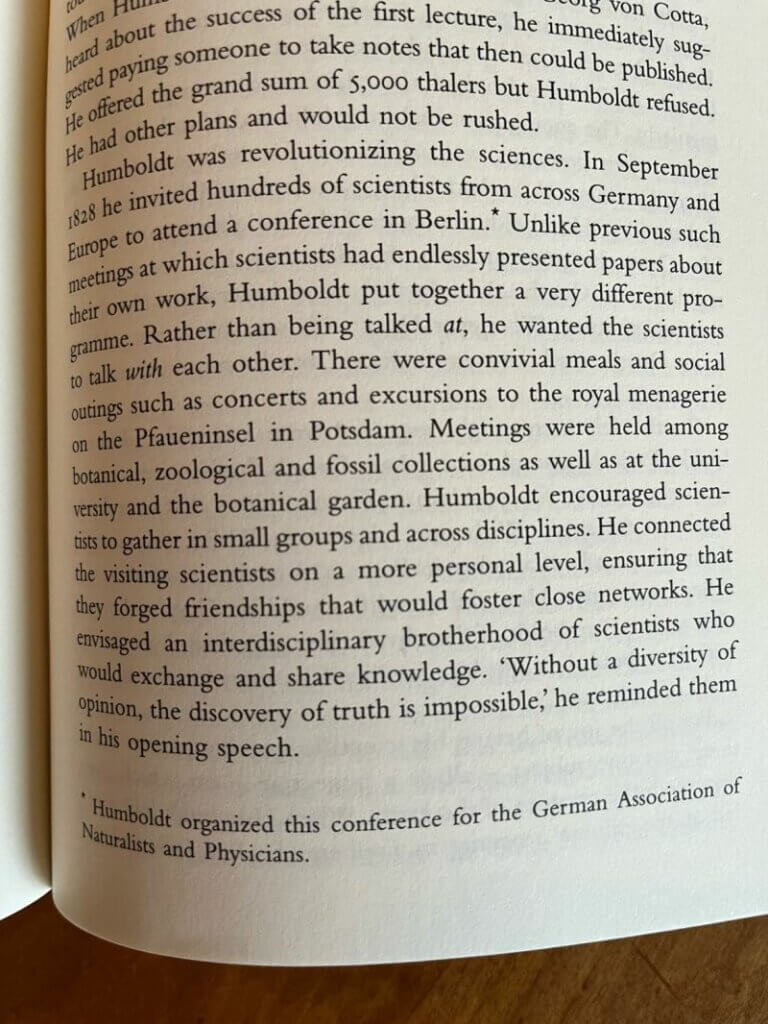I’m indebted to Martin Sirk for sharing remarkable information about an 1828 conference designed by the German geographer, naturalist, and explorer Alexander von Humboldt. Read what follows to discover that Humboldt was also a meeting designer way ahead of his time!
“Humboldt was revolutionizing the sciences. In September 1828 he invited hundreds of scientists from across Germany and Europe to attend a conference in Berlin.* Unlike previous such events at which scientists had endlessly presented papers about their own work, Humboldt put together a very different programme. Rather than being talked at, he wanted the scientists to talk with each other. There were convivial meals and social outings such as concerts and excursions to the royal menagerie on the Pfaueninsel in Potsdam. Meetings were held among botanical, zoological and fossil collections as well as at the university and the botanical garden. Humboldt encouraged scientists to gather in small groups and across disciplines. He connected the visiting scientists on a more personal level, ensuring that they forged friendships that would foster close networks. He envisioned an interdisciplinary brotherhood of scientists who would exchange and share knowledge. ‘Without a diversity of opinion, the discovery of truth is impossible; he reminded them in his opening speech.
*Humboldt organized this conference for the German Association of Naturalists and Physicians.”
—Andrea Wulf, “The Invention of Nature: Alexander von Humboldt’s New World“
A meeting designer way ahead of his time
Humboldt implemented, in 1828, many features of today’s participant-driven, participation-rich conferences.
In one way this is not surprising, as I’ve mentioned in my brief history of the development of conferences in my book Conferences That Work.
“These Conferences are held once in a Month by divers Able Masters making reflexions and observations upon the rarest pieces in the Cabinet of his Most Christian Majesty…”
—A Relation of the Conferences Held at Paris in the Academy Royal for the Improvement of the Arts of Painting and Sculpture, as ‘tis Found in the Journal Des Scavans, A. E. H. Love in Philosophical Transactions (1665–1678), Vol. 4, 1669We don’t know much about the Able Masters of the Academy Royal who began holding their art conferences in 1666, but given that the mid-17th century was the dawn of formal art criticism, I don’t think the Able Masters sat in rows listening to Abler Masters. Instead, I visualize a room of fledgling critics, magnificently gowned, standing around a Leonardo da Vinci drawing while arguing about the role of perspective in painting, creating a witty salon of a conference, full of arguments and opinions shared among peers.
This vision of mine is a fantasy—yet it illustrates an important point. When a new area of human knowledge or interest blossoms, there are no experts—only a vanguard struggling to see clearly, to understand more deeply, to learn. During this period a traditional conference format can only offer an uneasy fit—if there are no experts yet, who will present? Today’s explosion of knowledge and, hence, associated conference topics, implies an increasing need for flexible conference approaches that can adapt to spontaneous, real-time discoveries of directions and themes that attendees want to explore.
—From Chapter 1 of Conferences That Work
When people create a community of practice for any new profession, topic, or issue, its initial meeting form is very similar to what Humboldt did. (Or what I and others did when we wanted to meet with peers about implementing administrative computing in small schools in 1992, leading to the formation of edACCESS.)
That’s because when a community of practice forms, there are no “experts” or community members with high relative status because no one knows each other. Unfortunately, it’s common for such communities to stratify over time when they meet, as they revert to the dominant one-teacher-many-learners model we experience throughout our schooling.
Peer conferences/unconferences buck this trend. They provide meeting processes that remain open to the likelihood that every participant has something to offer other participants. They make it as easy as possible to discover peers who are useful resources for each other. Finally, they continue to respect the reality that the smartest person in the room is the room.
So we can reasonably assume that the earliest “conferences” were quite similar to the peer conferences/unconferences of today. Humboldt “envisioned an interdisciplinary brotherhood of scientists who would exchange and share knowledge”. Replace “scientists” with your community description of choice (and find a more gender-neutral word for “brotherhood” if there is one) and you have a decent description of what my work is about.
Humboldt was a privileged, high-status man living two hundred years ago. What is remarkable about his meeting design is that he didn’t simply replicate the status quo. Instead, he created a conference that maximized participant connection, used multiple interesting venues to meet, and emphasized small group conversations. Impressive!



“….ensuring that they forged friendships that would foster close networks.” Humboldt was clearly a great social psychologist as well as brilliant geographer, biologist, ecologist, explorer, geologist, and meeting designer!!!
The word “polymath” certainly applies!